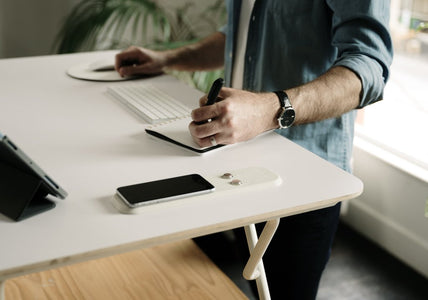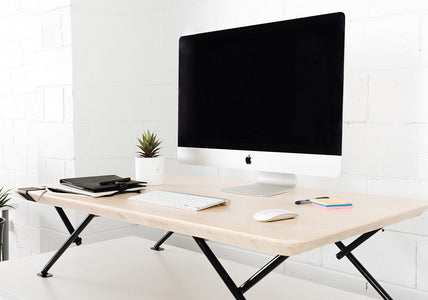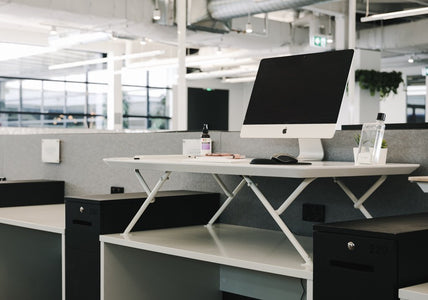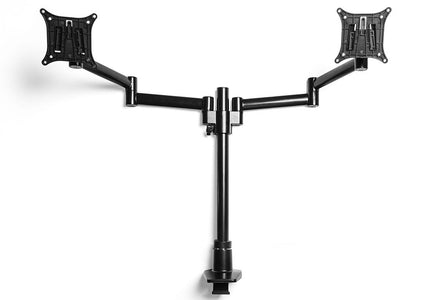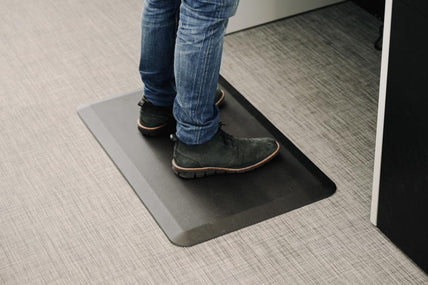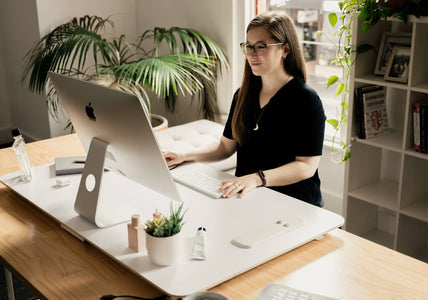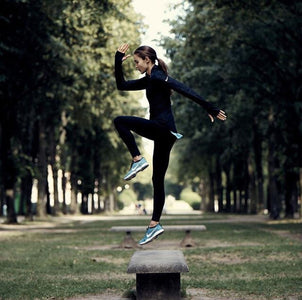5 Tips to Get the Best Use of Your Movi Standing Desk Setup
By Daniel Angelini on January 18, 2021With ergonomics as the centre of discussion in providing the best work desk setup possible, there’s no better way to improve your posture than through investing in a standing desk setup. Now that many people are working from home instead of making their way to the office, they’re spending even more time seated and less time moving. Staying sedentary is one of the surefire ways to develop a wide range of health issues, from poor posture to obesity. It’s vital to keep moving, and a stand-up workspace helps you do that.
There are numerous benefits to a standing desk setup. Apart from improving your posture and overall ergonomics, it also boosts your focus, energy, and productivity. However, most new owners of standing desks aren’t sure how to balance sitting and standing. It’s just as important to sit as it is to stand, and the end goal is to move more—not altogether quit sitting.
Your Sit-Stand Goals
As your objective is to stand and move around more while remaining productive, using a standing desk will hit two birds with one stone. You must stand anywhere between 5 to 45 minutes at a time for an hour for best results; that way, you get a proper balance between the two. The goal is to stand for about 50 per cent of your workday, which should be approximately 4 hours. If you prefer to work while standing, that’s great! However, make sure you don’t go beyond 80 per cent of your workday or around 6 hours. Too much standing is just as bad as too much sitting.
With your standing desk setup, you should be minimising your sitting sessions to about 30 minutes at a time. Although that doesn’t sound like much, it’s easy to feel a little too comfortable, and you’ll end up sitting for hours on end. Be sure to change positions, stretch, or go for a quick walk every 30 to 45 minutes to get your blood circulating.
Now that you have a baseline for your sitting and standing goals, it’s now time to keep these tips in mind:
You might feel like you have to make up for all the time you’ve sat down at work, intent on getting things done ASAP. Maybe you want to undo the damage that being hunched over your desk for years has done to your posture. While that’s all well and good, moderation is key in everything—including sitting and standing!
The ratio of sitting to standing is between 1:1 and 3:1 according to a study from the University of Waterloo, which means that for every hour you sit, you must stand an equal amount of time. The recommended standing time is actually up to 3 hours for every 1 hour you spend sitting, which means that you’ll be standing around 4 to 6 hours in a regular 8-hour workday.
However, you shouldn’t do these estimates straight. It’s best to break them into smaller sessions so that you can alternate between standing and sitting often. Be sure to spend no more than 1.5 hours at a time standing and no more than 30 minutes straight while seated.
The chances are that you’ve spent a significant amount of time seated at a desk. Whether you’re a fresh grad or well into your career, you’ve been working while sitting at a table since you started school. Just like you wouldn’t run a marathon right when you begin to exercise, you shouldn’t be standing for hours on end when you first receive your standing desk.
It’s best to start slow when adjusting to your new stand-up workspace. Stand for around an hour a day, but break this up in small sessions of around 15 to 20 minutes. Although this may seem like a small amount, you don’t want to overexert your body, especially if you’re used to sitting most of the time. Once you’ve gotten the hang of it, you can increase your standing time by 5 to 10 minutes a week. You can then work towards your ideal range when you’re comfortable.
Increasing your standing time isn’t the only important part of using your standing desk correctly. You’ll also have to apply stand-up desk ergonomics to prevent muscle pain in other areas while you’re working. Keep your neck neutral and your wrists straight. Pull your shoulders back, so they’re tall and straight, not hunched or slouched. Your elbows must also be at a 90-degree angle.
Bend your knees while you’re standing to reduce any pressure on your hips. It’s also a good idea to keep a footrest handy, so you can shift your body weight from one foot to the other, which will help you keep moving while minimising the strain on your feet and back.
One of the best parts about a standing desk setup is that you can choose what you are most comfortable with when completing specific tasks. If you discover that you’re more focused while standing, you may be choosing to write while standing. However, other people like to do tasks that need less focus while standing, like reading. If you need fine motor skills or precision for a particular activity, you may find that you should do it while seated.
Experiment with how you feel while sitting and standing and match it to your tasks as you see fit. That way, you get to experiment and find the combination that works best for you.
The ultimate goal of standing desks is to increase activity, so it’s up to you to decide how to distribute your standing sessions. You’re free to move or stand as much as you wish—whether you want to change positions every 15 minutes or stand for 40 minutes then sit for 20, what’s important is that you keep moving.
As long as you keep changing things up, you can’t go wrong. Just remember that moderation is key and too much of either standing or sitting will do you more harm than good.
Conclusion
Standing desks are a great way to change the way you work. If you begin to feel cramped after sitting too long, then a standing desk will keep you at your feet while helping you stay productive at work. It’s even more useful when you’re working from home, where you’re most likely to remain sedentary for even longer. By keeping these five tips in mind, you’ll be getting the best use out of your standing desk in no time.
Intending to make workplaces healthier and more productive in just a few seconds, MOVI offers height adjustable standing desks in Australia. We can convert your existing desk into a smart, automated-lift standing desk in seconds, bringing you higher productivity and better health at work every day. Check out our catalogue today for your next standing desk!
